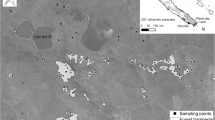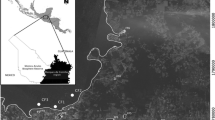Abstract
We evaluated the effect of tropical dry forest edges in fragments on reptile structure and ecological groups, and their relationship to 15 environmental variables in the Caribbean Region, Colombia. We used 15 pasture-edge-interior gradients and 12 permanent linear transects per gradient, sampling them on three occasions between January and December 2006. We recorded 35 species (pasture: 15, forest edge: 28, forest interior: 16). Reptile structure was different along the pasture-edge-interior gradient and the magnitude of the influence of the edge effect on the abundance of the most common species changed from the dry to rainy season. We identified seven ecological groups based on three fixed functional traits: species habit, size and reproductive mode. The proportion of species belonging to each ecological group was different between the pasture and forest habitats, but there were no differences between the forest edge and its interior. Four of the seven ecological groups inhabited pasture and the forest interior, and all of the ecological groups were represented in the forest edge. The ecological group with oviparous small and diurnal species accounted for the 50 % of the species inhabiting the forest interior. Reptile structure and ecological groups were both related to patch size, elevation, herbaceous cover, percentage of bare soil and temperature, but explanatory power differed. We suggest that the conservation and management of tropical dry forest reptiles should take into account species traits so that rather than using information for a single species, a more generalized community approach is used.




Similar content being viewed by others
References
Anderson L, Burgin S (2002) Influence of woodland remnant edges on small skinks (Richmond, New South Wales). Austral Ecol 27:630–637
Anderson MJ, Gorley RN, Clarke KR (2008) PERMANOVA+ for PRIMER: guide to software and statistical methods. PRIMER-E, Plymouth
Ávila-Pires TC (1995) Lizards of brazilian amazonia (Reptilia: Squamata). Zool Verh Leiden 299:1–706
Blaum N, Mosner E, Schwager M, Jeltsch F (2011) How functional is functional? Ecological groupings in terrestrial animal ecology: towards an animal functional type approach. Biodivers Conserv 20:2333–2345
Carvajal-Cogollo JE, Urbina-Cardona JN (2008) Patrones de diversidad y composición de reptiles en fragmentos de bosque seco tropical en Córdoba, Colombia. Trop Conserv Sci 1:397–416
Carvajal-Cogollo JE, Castaño-Mora OV, Cárdenas-Arévalo G, Urbina-Cardona JN (2007) Reptiles de áreas asociadas a humedales de la planicie del departamento de Córdoba, Colombia. Caldasia 29(2):427–438
Castaño-Mora OV (2002) Libro rojo de reptiles de Colombia. Libros rojos de especies amenazadas de Colombia. Instituto de Ciencias Naturales-Universidad Nacional de Colombia, Ministerio de Medio Ambiente, Conservación Internacional-Colombia. Bogotá
Champion HG, Seth SK (1968) Revised survey of the forest types of India. Manager of Publications, New Delhi
Clarke KR, Gorley RN (2006) PRIMER v6: user manual/tutorial. PRIMER-E, Plymouth
Cortés-Gómez AM, Castro-Herrera F, Urbina-Cardona JN (2013) Small changes in vegetation structure create great changes in amphibian ensembles in the Colombian Pacific rainforest. Trop Conserv Sci 6(6):749–769
Crump ML, Scott NY (1994) Visual encounter surveys. In: Heyer W, Donnelley MA, Mcdiarmid RA, Hayek LC, Foster MC (eds) Measuring and monitoring biological diversity: standard methods for amphibians. Smithsonian Institution, USA, pp 84–92
Di Rienzo JA, Casanoves F, Balzarini MG, Gonzalez L, Tablada M, Robledo CW (2008) InfoStat, versión 2008. Grupo InfoStat, FCA, Universidad Nacional de Córdoba, Argentina
Díaz S, Cabido M (2001) Vive la différence: plant functional diversity matters to ecosystem processes. Trends Ecol Evol 16:646–655
Flynn DFB, Gogol-Prokurat M, Nogeire T, Molinari N, Richers BT, Lin BB, Simpson N, Mayfield MM, DeClerck F (2009) Loss of functional diversity under land use intensification across multiple taxa. Ecol Lett 12(1):22–33
Gardner TA, Ribeiro-Junior MA, Barlow J, Ávila-Pires TCS, Hoogmoed MS, Peres CA (2007) The value of primary, secondary, and plantation forests for a neotropical herpetofauna. Conserv Biol 21:775–787
Giraldo JP, Holbrook NM (2011) Physiological mechanisms underlying the seasonallity of leaf senescence and renewal in seasonally dry tropical forest trees. In: Dirzo R, Young HS, Mooney HA, Ceballos G (eds) seasonally dry tropical forest. Island Press, Washington, DC, pp 129–140
Glor RE, Flecker AS, Benard MF, Power AG (2001) Lizard diversity and agricultural disturbance in a Caribbean forest landscape. Biodivers Conserv 10:711–723
Harper KA, Macdonald SE, Burton PJ, Chen J, Brosofske KD, Saunsders SC, Euskirchen ES, Roberts D, Jaiteh MS, Essen PA (2005) Edge influence on forest structure and composition in fragmented landscapes. Conserv Biol 19:768–782
Hernández-Ordoñez O, Urbina-Cardona JN, Martinez-Ramos M (in press) Recovery of amphibian and reptile assemblages over old field succession in a Neotropical tropical rainforest region. Biotropica
Laurance WF, Lovejoy TE, Vasconcelos HL, Burna EM, Didham RK, Stouffer P, Gascon C, Bierregard RO, Laurance SG, Sampaio E (2002) Ecosystem decay of Amazonian forest fragments: a 22-year investigation. Conserv Biol 16:605–618
Lehtinen RM, Ramanamanjato J, Raveloarison JG (2003) Edge effects and extinction proneness in a herpetofauna from Madagascar. Biodivers Conserv 12:1357–1370
Luck GW, Harrington R, Harrison PA, Kremen C, Berry PM, Bugter R, Dawson TR, De Bello F, Diaz S, Feld CK, Haslett JR, Hering D, Kontogianni A, Lavorel S, Rounsevell M, Samways MJ, Sandin L, Settele J, Sykes MT, Van Den Hove S, Vandewalle M, Zobel M (2010) Quantifying the contribution of organisms to the provision of ecosystem services. Bioscience 59(3):223–235
Magurran A, McGill B (2011) Biological diversity frontiers in measurement and assessment. Oxford University Press, Oxford
MAVDT—Ministerio de Ambiente Vivienda y Desarrollo Territorial (2010) Cuarto Informe Nacional ante el Convenio sobre la Diversidad Biológica—República de Colombia, Bogotá
Mendenhall CD, Frishkoff LO, Santos-Barrera G, Pacheco J, Mesfun E, Mendoza Quijano F, Ehrlich PR, Ceballos G, Daily GC, Pringle RM (2014) Countryside biogeography of Neotropical reptiles and amphibians. Ecology 95:856–870
Miles L, Newton AC, DeFries RS, Ravilious C, May I, Blyth S, Kapos V, Gordon JE (2006) A global overview of the conservation status of tropical dry forests. J Biogeogr 33:491–505
Mooney HA, Bullock SH, Medina E (1995) Introduction. In: Bullock SH, Mooney HA, Medina E (eds) Seasonally dry tropical forests. Cambridge University Press, New York, pp 1–8
Moreno-Arias RA, Urbina-Cardona JN (2013) Population dynamics of the Andean lizard Anolis heterodermus: slow-fast demographic strategies in fragmented scrubland landscapes. Biotropica 45:253–261
Murcia C (1995) Edge effects in fragmented forests: implications for conservation. Trends Ecol Evol 10:58–62
Najmeh K, Kaboli M, Karami M, Alizadeh A, Teymurzadeh S, Khalilbeigi N, Murphy JB, Nourani E (2011) Captive management and reproductive biology of Latifi’s Viper (Montivipera latifii) (Squamata: Viperidae) at Razi Institute and Tehran University in Iran. Herpetol Rev 42:535–539
Parthasarathy N, Arthur Selwyn M, Udayakumar M (2008) Tropical dry evergreen forests of peninsular India: ecology and conservation significance. Trop Conserv Sci 1:89–110
Pérez- Santos C (1986) Las serpientes del Atlántico. Mus. Nac. Cienc. Nat. J. Gutiérrez Abascal, Madrid
Pérez-Santos C, Moreno A (1988) Ofidios de Colombia. Monografía, Torino, p 517
Pizano C, García H (2014) El Bosque Seco Tropical en Colombia. Instituto de Investigación de Recursos Biológicos Alexander von Humboldt (IAvH), Bogotá D.C., p 353
Pla L, Casanoves F, Di Rienzo J (2012) Quantifying functional biodiversity. Springer Editorial. Series: SpringerBriefs in Environmental Science, Berlin
Pough F, Andrews R, Cadle J, Crump M, Savitzky AH, Wells KD (2001) Herpetology First Edition. Ed Prenlice Hall, New Jersey
Rangel-Ch JO (2012) Colombia Diversidad Biótica XII. La región Caribe de Colombia. Universidad Nacional de Colombia-Instituto de Ciencias Naturales, CORPOCESAR, CVS, Bogotá DC
Rangel-Ch JO, Garay-Pulido H (2010) Bosques húmedos y secos circundantes a los complejos de humedales (Ciénagas), en el departamento de Córdoba. In: Rangel-Ch JO (ed) Colombia Diversidad Biótica IX: Ciénagas de Córdoba, Biodiversidad. Universidad Nacional de Colombia-Corporación Autónoma Regional de los Valles del Sinú y San Jorge, Bogotá DC, Ecología y Manejo Ambiental, pp 207–323
Reich PB (1995) Phenology of tropical forests: patterns, causes, and consequences. Can J Bot 73:164–174
Ribeiro LB, Sousa BM, Gomides SC (2009) Range structure, microhabitat use, and activity patterns of the saxicolous lizard Tropidurus torquatus (Tropiduridae) on a rock outcrop in Minas Gerais, Brazil. Rev Chil Historia Nat 82:577–588
Ries L, Fletcher RJ, Battin J, Sisk TD (2004) Ecological responses to habitat edges: mechanisms, models, and variability explained. Annu Rev Ecol Syst 35:491–522
Rivera O (2010) Flora. In: Rangel-Ch JO (ed) Colombia Diversidad Biótica IX: Ciénagas de Córdoba, Biodiversidad, Ecología y Manejo Ambiental. Universidad Nacional de Colombia-Corporación Autónoma Regional de los Valles del Sinú y San Jorge, Bogotá DC, pp 121–205
Sánchez-Azofeifa GA, Kalaczka ME, Quesada M, Stoner KE, Lobo JA, Arroyo-Mora P (2003) Tropical dry climates. In: Schwartz MD (ed) Phenology: an integrative environmental science. Klewer Academic Publishers, Dordrecht, pp 121–137
Santos-Barrera G, Urbina-Cardona JN (2011) The role of the matrix-edge dynamics of amphibian conservation in tropical montane fragmented landscapes. Rev Mex Biodiversidad 82:679–687
Sartorius SS, Vitt LJ, Colli GR (1999) Use of naturally and anthropogenically disturbed habitats in Amazonian rainforest by the teiid lizard Ameiva ameiva. Biol Conserv 90:91–101
Schlaepfer M, Gavin T (2001) Edge effects on lizards and frogs in tropical forest fragments. Conserv Biol 15:1079–1090
Suazo-Ortuño I, Alvarado-Díaz J, Martínez-Ramos M (2008) Effects of conversion of dry tropical forest to agricultural mosaic on herpetofaunal assemblages. Conserv Biol 22:362–374
Urbina-Cardona JN, Reynoso VH (2005) Recambio de anfibios y reptiles en el gradiente potrero-borde-interior en la Reserva de Los Tuxtlas, Veracruz, México. In: Halffter G, Soberón J, Koleff P, Melic A (eds) Sobre Diversidad Biológica: El significado de las Diversidades Alfa, Beta y Gamma. CONABIO, SEA, DIVERSITAS & CONACyT, vol 4. Editorial Monografías Tercer Milenio, Zaragoza, pp 191–207
Urbina-Cardona JN, Olivares-Pérez MI, Reynoso VH (2006) Herpetofauna diversity and microenvironment correlates across the pasture-edge-interior gradient in tropical rainforest fragments in the region of Los Tuxtlas. Veracruz Biol Conserv 132:61–75
Urbina-Cardona JN, Londoño-Murcia MC, García-Avila DG (2008) Dinámica espacio-temporal en la diversidad de serpientes en cuatro hábitats con diferente grado de perturbación antropogénica en el Parque Nacional Natural Isla Gorgona, Pacífico Colombiano. Caldasia 30:407–421
Valencia-Aguilar A, Cortés-Gómez AM, Ruiz-Agudelo CA (2013) Ecosystem services provided by amphibians and reptiles in Neotropical ecosystems. Int J Biodivers Sci Ecosyst Serv Manage 9(3):257–272
Van Horne B (1983) Density as a misleading indicator of habitat quality. J Wildl Manage 47:893–901
Vandewalle M, de Bello F, Berg MP, Bolger T, Dolédec S, Dubs F, Feld CK, Harrington R, Harrison PA, Lavorel S, da Silva PM, Moretti M, Niemelä J, Santos P, Sattler T, Sousa JP, Sykes MT, Vanbergen Woodcock BA (2010) Functional traits as indicators of biodiversity response to land use changes across ecosystems and organisms. Biodivers Conserv 19(10):2921–2947. doi:10.1007/s10531-010-9798-9
Violle C, Navas ML, Vile D, Kazakou E, Fortunel C, Hummel I, Garnier E (2007) Let the concept of trait be functional! Oikos 116:882–892
Williams-Linera G, Domínguez-Gastelú V, García-Zurita ME (1998) Microenvironment and floristic of different edges in a fragmented tropical rainforest. Conserv Biol 12:1091–1102
Zug G, Vitt L, Caldwell J (2001) Herpetology: an introductory biology of amphibians and reptiles. Academic Press, NY
Acknowledgments
O.V. Castaño-Mora and J.O. Rangel-Ch provided valuable suggestions that improved the manuscript. R. Pedroza, R. Moreno-Arias, G.F. Medina-Rangel & G. Cárdenas collaborated during the field work and on the taxonomic identification of specimens. Specimens were collected under permit 27 issued in 2006 by the Corporación Autónoma Regional de los Valles del Sinú y San Jorge (CVS)-Universidad Nacional de Colombia (UNAL) and deposited in the UNAL Reptile Collection at the Instituto de Ciencias Naturales. This research was funded by inter-administrative agreement No. 27 between UNAL and CVS. We are grateful to A.O. Rivera-Diaz for assistance in measuring the plant variables. B. Delfosse enthusiastically assisted in editing the English version of this document. J.J. Motta and E. Guerra adviced data analysis in PRIMER software.
Author information
Authors and Affiliations
Corresponding author
Additional information
Communicated by Iain James Gordon.
Electronic supplementary material
Below is the link to the electronic supplementary material.
Rights and permissions
About this article
Cite this article
Carvajal-Cogollo, J.E., Urbina-Cardona, N. Ecological grouping and edge effects in tropical dry forest: reptile-microenvironment relationships. Biodivers Conserv 24, 1109–1130 (2015). https://doi.org/10.1007/s10531-014-0845-9
Received:
Revised:
Accepted:
Published:
Issue Date:
DOI: https://doi.org/10.1007/s10531-014-0845-9




